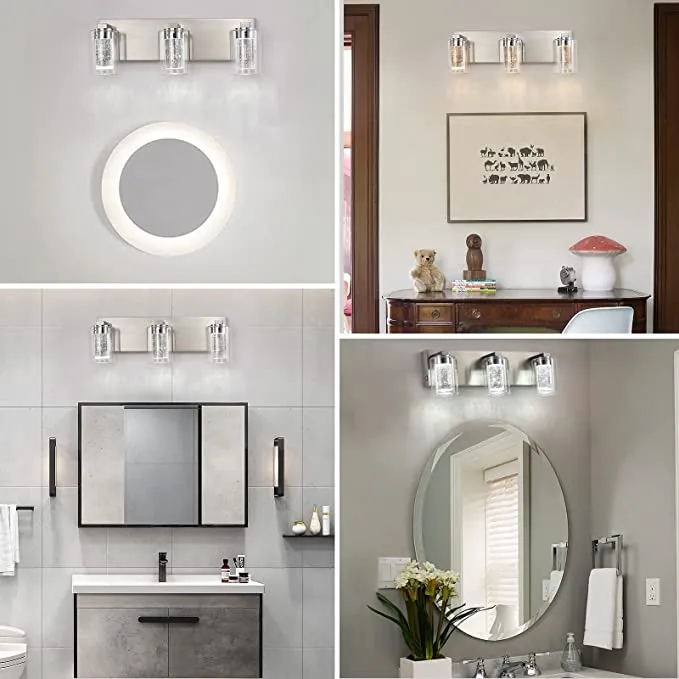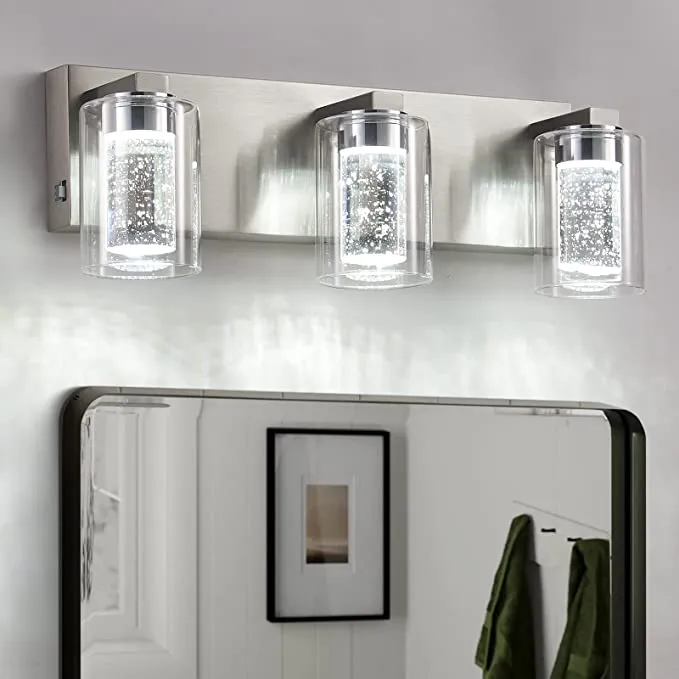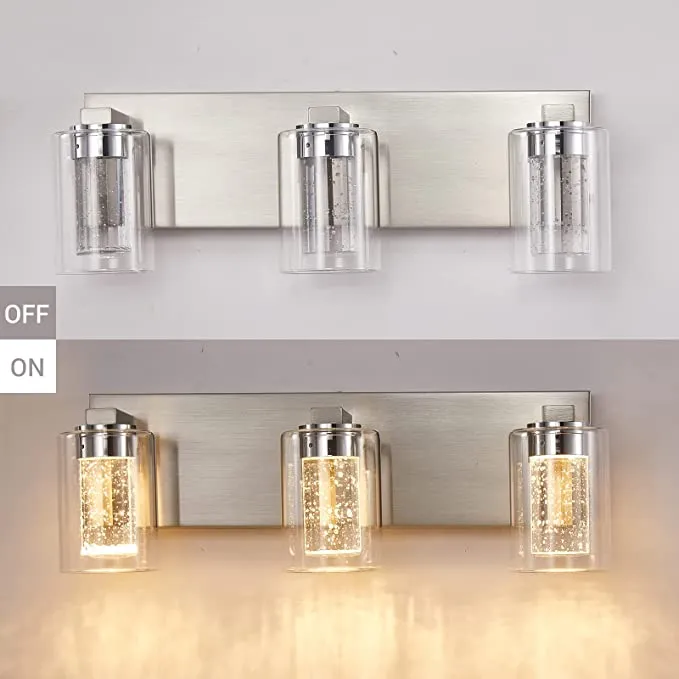What are the rules for vanity lighting?
Whether applying makeup, skincare, or simply grooming, a well-designed lighting environment not only enhances convenience but also directly impacts visual comfort and operational precision. Therefore, the question of "what are the rules for vanity lighting" has become a hot topic.
This article will comprehensively analyze the rules for vanity lighting from multiple perspectives, including light source selection, fixture placement, color temperature standards, brightness control, space safety, and fixture types. It will also emphasize the importance and proper use of vanity light fixtures.

Vanity Light Fixtures: Light Source Selection Rules
The light source selection for vanity light fixtures is a fundamental component of the entire lighting system. The properties of the light source will determine the realism and comfort of the lighting effect.
1. Prefer LED Light Sources
Currently, the most common light source for vanity light fixtures is LED. LED light sources not only provide stable brightness but also offer advantages such as energy efficiency, long lifespan, and low heat generation. In confined bathrooms or bedrooms, LED vanity light fixtures can avoid the discomfort caused by overheating from traditional incandescent lamps.
2. Provide even and soft lighting
Vanity light fixtures should avoid using harsh, high-spot light sources. Uneven lighting can cause shadows on the face, affecting the appearance of makeup or contouring. LED vanity light fixtures with frosted lampshades or diffuser panels can effectively address this issue.
3. Color Rendering Index (CRI) ≥ 90
The higher the CRI of vanity light fixtures, the more realistic the colors appear. Especially during makeup application, a low CRI can easily cause a color cast. Therefore, vanity light fixtures should use LED lamps with a CRI ≥ 90.

Vanity Light Fixtures: Lamp Installation Positioning Rules
Lamp location directly affects the lighting effect. A proper installation layout can minimize shadows and flare, ensuring clear and natural facial details.
1. Double-sided lighting is better than single toplighting
One of the key principles of vanity light fixture placement is to avoid placing the light source solely overhead. A single toplight can easily create shadows under the eyes and on the sides of the nose. A more scientific approach is to choose vanity light fixtures with symmetrical placement on both sides, which evenly illuminate the face from both sides and minimize shadows.
2. Eye-level or slightly higher
The recommended installation height for vanity light fixtures is generally at eye level, or slightly above 5-10 cm. This ensures direct light on the face, without creating harsh shadows due to installation heights too low or too high.
3. Avoid backlighting
Backlighting from a dressing table can cause the face to appear too dark, negating the lighting's purpose. Therefore, vanity light fixtures should be installed directly in front of or on the sides, avoiding situations where only the main room light is providing illumination.

Vanity Light Fixtures: Color Temperature Selection Guidelines
Color temperature is one of the core criteria for the lighting effect of vanity light fixtures. The right color temperature ensures that makeup looks accurate under natural light.
1. Recommended Color Temperature Range: 3000K-5000K
The optimal color temperature range for vanity light fixtures is between 3000K and 5000K.
• Around 3000K (warm white light): Soft and warm, suitable for nighttime use, providing a comfortable and relaxing experience.
• Around 4000K (neutral white light): Approximates daylight color, maintaining clarity while avoiding an overly cold light effect.
• Around 5000K (cool white light): Closest to daylight, suitable for detailed makeup applications, contouring, and other scenes requiring high fidelity.
2. Avoid color temperatures that are too high or too low
Color temperatures below 2700K cast a yellowish cast, easily affecting the judgment of makeup. Color temperatures above 6000K cast a bluish cast, making the light too cold and unnatural, potentially causing visual fatigue.
Vanity light fixtures: Brightness control rules
The brightness of vanity light fixtures should not be fixed but adjusted according to different needs.
1. Recommended brightness: 500-800 lumens
General vanity light fixtures are recommended to provide a luminous flux of 500-800 lumens, which meets lighting needs without excessive glare.
2. Graded Dimming Design
LED vanity light fixtures with dimming functions are particularly practical. High brightness can be used when applying makeup, while soft mode can be used for simple nighttime washing to avoid eye irritation.
3. Avoid Reflections and Glare
Dressing table mirrors are prone to reflections. Improper fixture installation can cause glare, impacting the user experience. Lampshades, diffusers, or frosted finishes can effectively mitigate this issue.

Vanity Light Fixtures: Safety Principles
Since dressing tables are often located in bathrooms or near sinks, where humidity is high, safety is a crucial consideration for vanity light fixtures.
1. Waterproof Rating IP44 or Above
For vanity light fixtures, it is recommended to choose LED fixtures with a waterproof and dustproof rating of IP44 or above, which are resistant to splashing water and moisture.
2. Low Voltage Priority
To avoid the risk of electrical damage in wet areas, low-voltage LED fixtures should be used for vanity light fixtures to minimize the risk of electric shock.
3. Install away from water sources
Although vanity light fixtures are waterproof, they should still be kept away from direct water sources such as faucets and showerheads to ensure safe use.
Vanity light fixtures: Appearance and Functional Rules
Vanity light fixtures are not only lighting tools but also part of the aesthetics of a space. Well-designed appearance and functionality can further enhance the user experience.
1. Choose vanity light fixtures that complement the overall style of the space
Whether it's modern minimalist or retro European, vanity light fixtures should blend in with the overall space to avoid being intrusive.
2. Combine mirror lights with wall lamps
In addition to traditional vanity light fixtures, you can install wall lamps above or on either side of the mirror to create a three-dimensional light source for more balanced facial lighting.
3. Smart Features
Vanity light fixtures with touch controls and memory dimming functions are not only easy to use but also automatically adjust brightness based on user habits, enhancing comfort.
What are the rules for dressing table lighting?
Dressing table lighting isn't something you can arrange arbitrarily; instead, there's a set of scientific and rational rules.
• For the light source, choose LEDs with a high color rendering index.
• For the installation location, prioritize dual-sided lighting to avoid shadows.
• For color temperature, it's recommended to stay within the 3000K-5000K range.
• For brightness, ensure adequate illumination and dimming capabilities.
• For safety, choose vanity light fixtures that are waterproof and dustproof.
• For functionality and aesthetics, balance practicality and decorativeness.
In summary, the lighting rules for vanity light fixtures cover multiple aspects, including light source, layout, color temperature, brightness, safety, and aesthetics. Only by following these rules can you create a dressing table lighting environment that is both safe and comfortable, practical, and beautiful, making daily grooming and beauty routines more efficient, precise, and enjoyable.
Why buy LED lights directly from a factory like Huari?
Purchasing directly from Huari Lighting means cutting out middlemen and enjoying low factory prices with guaranteed quality. As a Chinese manufacturer with more than 92,000㎡ of production space, we ensure stable supply for global buyers. Our sales team provides fast quotes, customized solutions, and wholesale discounts.
Unlike trading companies, we control every step of production. This allows customers to buy high quality LED lights at cheap prices with reliable after-sales support and continuous supply.
